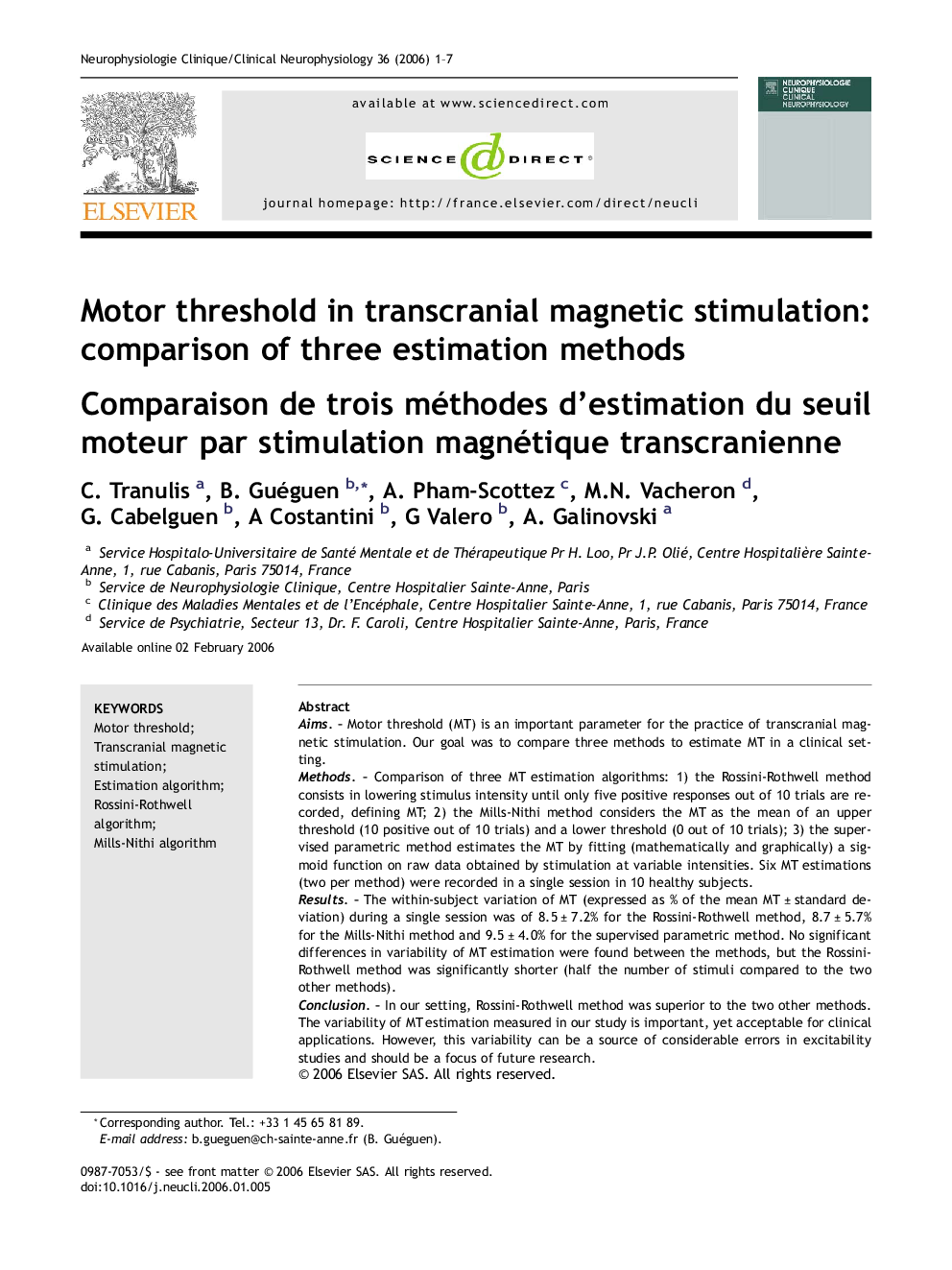| کد مقاله | کد نشریه | سال انتشار | مقاله انگلیسی | نسخه تمام متن |
|---|---|---|---|---|
| 3083313 | 1189561 | 2006 | 7 صفحه PDF | دانلود رایگان |

Aims. – Motor threshold (MT) is an important parameter for the practice of transcranial magnetic stimulation. Our goal was to compare three methods to estimate MT in a clinical setting.Methods. – Comparison of three MT estimation algorithms: 1) the Rossini-Rothwell method consists in lowering stimulus intensity until only five positive responses out of 10 trials are recorded, defining MT; 2) the Mills-Nithi method considers the MT as the mean of an upper threshold (10 positive out of 10 trials) and a lower threshold (0 out of 10 trials); 3) the supervised parametric method estimates the MT by fitting (mathematically and graphically) a sigmoid function on raw data obtained by stimulation at variable intensities. Six MT estimations (two per method) were recorded in a single session in 10 healthy subjects.Results. – The within-subject variation of MT (expressed as % of the mean MT ± standard deviation) during a single session was of 8.5 ± 7.2% for the Rossini-Rothwell method, 8.7 ± 5.7% for the Mills-Nithi method and 9.5 ± 4.0% for the supervised parametric method. No significant differences in variability of MT estimation were found between the methods, but the Rossini-Rothwell method was significantly shorter (half the number of stimuli compared to the two other methods).Conclusion. – In our setting, Rossini-Rothwell method was superior to the two other methods. The variability of MT estimation measured in our study is important, yet acceptable for clinical applications. However, this variability can be a source of considerable errors in excitability studies and should be a focus of future research.
RésuméButs. – Étudier la qualité de l'estimation du seuil moteur (SM) dans un contexte clinique.Méthodologie.– Comparer trois algorithmes de mesure du SM : 1) la méthode Rossini-Rothwell débute à une forte intensité de stimulation, diminuant jusqu'à l'obtention de seulement cinq réponses motrices sur dix essais ; 2) la méthode Mills-Nithi considère le SM comme la moyenne entre le seuil inférieur (aucune réponse motrice en 10 essais) et le seuil supérieur (10 réponses sur 10 essais) ; 3) la méthode paramétrique supervisée estime le SM superposant (mathématiquement et graphiquement) une fonction sigmoïdale sur les données obtenues en stimulant à des intensités variables. Pendant une séance unique, six mesures du SM (deux par méthode) ont été obtenues chez dix volontaires sains.Résultats. – La variabilité intrasujet de la mesure du SM (exprimé en % du SM moyen ± l'écart-type) a été de 8,5 ± 7,2 % pour la méthode Rossini-Rothwell, 8,7 ± 5,7 % pour Mills-Nithi et 9,5 ± 4,0 % pour la méthode paramétrique supervisée. Il n'y a pas eu de différence significative entre la variabilité de la mesure parmi les trois méthodes. Cependant, la méthode Rossini-Rothwell a été plus rapide, nécessitant environ 50 % moins de stimulations par mesure.Conclusions. – Dans cette étude, la méthode Rossini-Rothwell semble supérieure aux deux autres algorithmes. La variabilité de l'estimation du SM observée dans notre étude, tout en étant acceptable pour les applications thérapeutiques, peut représenter une source d'erreur significative dans les études d'excitabilité corticale.
Journal: Neurophysiologie Clinique/Clinical Neurophysiology - Volume 36, Issue 1, January–February 2006, Pages 1–7